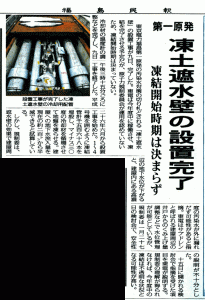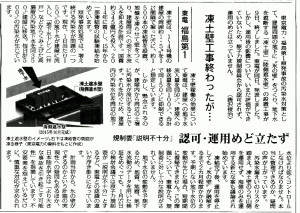Original Japanese written by staffer
The English below written and arranged by Heeday, based on the original Japanese
The English edited by Rev. Dr. Henry French, ELCA
Articles from the February 10th, 2016 editions of the Fukushima Minpo, Asahi Shimbun, and Akahata newspapers
▼Click each image to read an English summary of the Japanese article.
In its struggle to contain the contaminated water from the Fukushima Daiichi Nuclear Power Plant (NPP), TEPCO has resorted to building “ice walls*.” Presently, the walls are there, and yet the power company cannot start the final “freezing” of the walls. Japan’s Nuclear Regulation Authority (NRA) refuses to give the wall freezing a go-ahead, pointing out that rather than containing such water, as claimed by the power company, the water-shields could lead to further leakage of contaminated water. On February 9th, TEPCO announced the wall building work was done. Still, no one knows if the NRA will ever approve the walls for use.
(*) What are the “ice walls”?
At the Fukushima Daiichi NPP, under the reactor buildings where the melted nuclear fuel has fallen to the ground, underground water has been running into contact with the melted fuel, creating highly contaminated water. To counteract this, TEPCO announced a plan to surround the underground portions of reactors 1 through 4 with “ice walls,” 1,500m (0.93 mile) in total length. TEPCO installed numerous freezer pipes, 1,568 in number, 30m (33 yards) below the ground surface, with two pipes 1m (1.1 yard) apart from each other. The plan is to circulate a liquid coolant, 30C below the freezing point (22F below zero), through those pipes to freeze the soil surrounding the pipes. There is no precedence for such gigantic ice walls, however, and no evidence that the power company can maintain the frozen walls until 2020, as it claims to be able to do. Naturally, many are voicing their concerns over the ice wall plan. TEPCO is spending some JPY34.5 billion on the walls, which could well prove to be a huge extravagance.
What is wrong with the “ice walls”?
The Nuclear Regulation Authority (NRA) of Japan must give approval to the walls, yet the NRA has been doubtful about their effectiveness since the very beginning. If the underground water level goes below the ice walls, some of the highly contaminated water from the reactor buildings could leak into the soil outside the walls.
The NRA’s committee to determine whether or not the walls can function safely has asked the power company, over and over again, why it insists on the ice walls among so many other options. The committee’s chairperson, Mr. Shunichi Tanaka, even went on to say, “TEPCO’s grave error is that it is spreading the false belief that the ice walls, once built, can eliminate the whole issue of contaminated water,” in the spring of 2015.
Can be serious —
In fact, TEPCO held a trial freezing of the walls in 2015, and discovered the underground water level was lower than expected in some places. The levels differed from one location to another, and much remains unknown about the water flow rates and directions. Those walls, once frozen, take 2 months or so to melt. Thus, in case a problem is detected, no quick fix exists.
TEPCO vs NRA
The Fukushima Daiichi premises now hold more than 700,000 t (1,543,234 lb.) of processed yet still contaminated water, and it is hard to build more water tanks to accommodate it. Thus, TEPCO is insistent upon cutting down the volume of new contaminated water, while the NRA is determined to prevent any leakage of such water. In-spite-of these differences, wall building work was almost completed in December 2015, when the NRA made an exceptional written “suggestion” to TEPCO that they should “partially freeze” the ice walls to reduce the risk of some contaminated water leaking out of the reactor buildings. Still, the power company is determined to completely freeze the entire walls, although it is considering the NRA’s “suggestion.”



